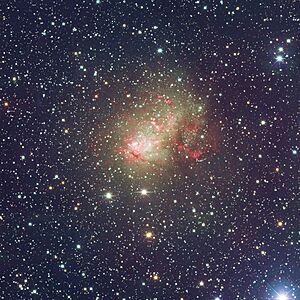IC 10 facts for kids
IC 10 is a special type of galaxy called an irregular galaxy. You can find it in the constellation called Cassiopeia, which looks like a "W" or "M" shape in the night sky.
Scientists first found IC 10 in 1887. For many years, they wondered if it was part of our own group of galaxies, called the Local Group. In 1962, they measured how fast IC 10 was moving. It was actually rushing towards our Milky Way galaxy at about 350 kilometers per second! This made scientists think it probably was part of the Local Group. Finally, in 1996, they used special stars called Cepheids to measure its exact distance. This confirmed that IC 10 is indeed a member of our Local Group. Even though it's close, it's hard to study because it's hidden behind a lot of dust and gas in the flat part of our Milky Way galaxy.
IC 10 seems to be about the same distance from the Andromeda Galaxy as the Triangulum Galaxy is. This suggests that IC 10 might be part of a smaller group of galaxies that orbit the Andromeda Galaxy.
A Galaxy Making Stars Fast
IC 10 is the only known starburst galaxy in our Local Group. A starburst galaxy is a galaxy that is making new stars at an incredibly fast rate. It has many more very big, hot, and bright stars called Wolf-Rayet stars compared to other nearby galaxies like the Large Magellanic Cloud or the Small Magellanic Cloud.
Even though IC 10 shines as brightly as the Small Magellanic Cloud, it is actually much smaller. The way these Wolf-Rayet stars have developed suggests they all formed around the same time, in a short burst. IC 10 creates new stars at a rate of about 0.04 to 0.08 solar masses (the mass of our Sun) each year. This means it has enough gas to keep making stars for billions of years more!
Dust and Gas in IC 10
When scientists looked at IC 10 using far-infrared light, they found something interesting. The dust in this starburst galaxy doesn't have many small grains. It's possible that strong ultraviolet light from the hot, bright stars destroyed these tiny dust particles.
IC 10 also has a huge cloud of hydrogen gas around it. This gas cloud looks much bigger in the sky (about 68 by 80 arcminutes) than the galaxy itself does in visible light (about 5.5 by 7.0 arcminutes). Another unusual thing about IC 10 is that the main part of the galaxy seems to spin in a different direction than its outer gas cloud. It also has a bright, glowing area in its center called an H II nucleus, which is a place where new stars are forming.
Images for kids
-
IC 10 taken by Hubble.
See also
 In Spanish: Galaxia IC 10 para niños
In Spanish: Galaxia IC 10 para niños



